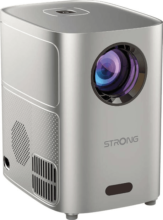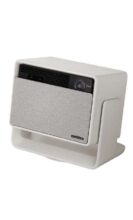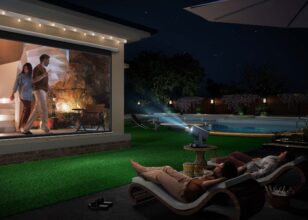OPTOMA UHZ55 Review: Optoma projector hits the right notes
A subtle upgrade on what’s gone before, OPTOMA UHZ55, this new laser-based 4K DLP beamer, beguiles Steve May with its pin-sharp presentation. Read our review.
IT WAS TAYLOR Swift who sold me on this new projector from Optoma. The pop artist’s Eras Tour concert show, streaming on Disney+, is dazzling 4K eye candy and appears tailor-made for the UHZ55.
As Swift patrolled the stage, her sequinned outfit glittering under dancing spotlights, I couldn’t imagine how any rival projector around this price point could look better. Its pristine performance stayed with me long after the show finished. I couldn’t shake it off.
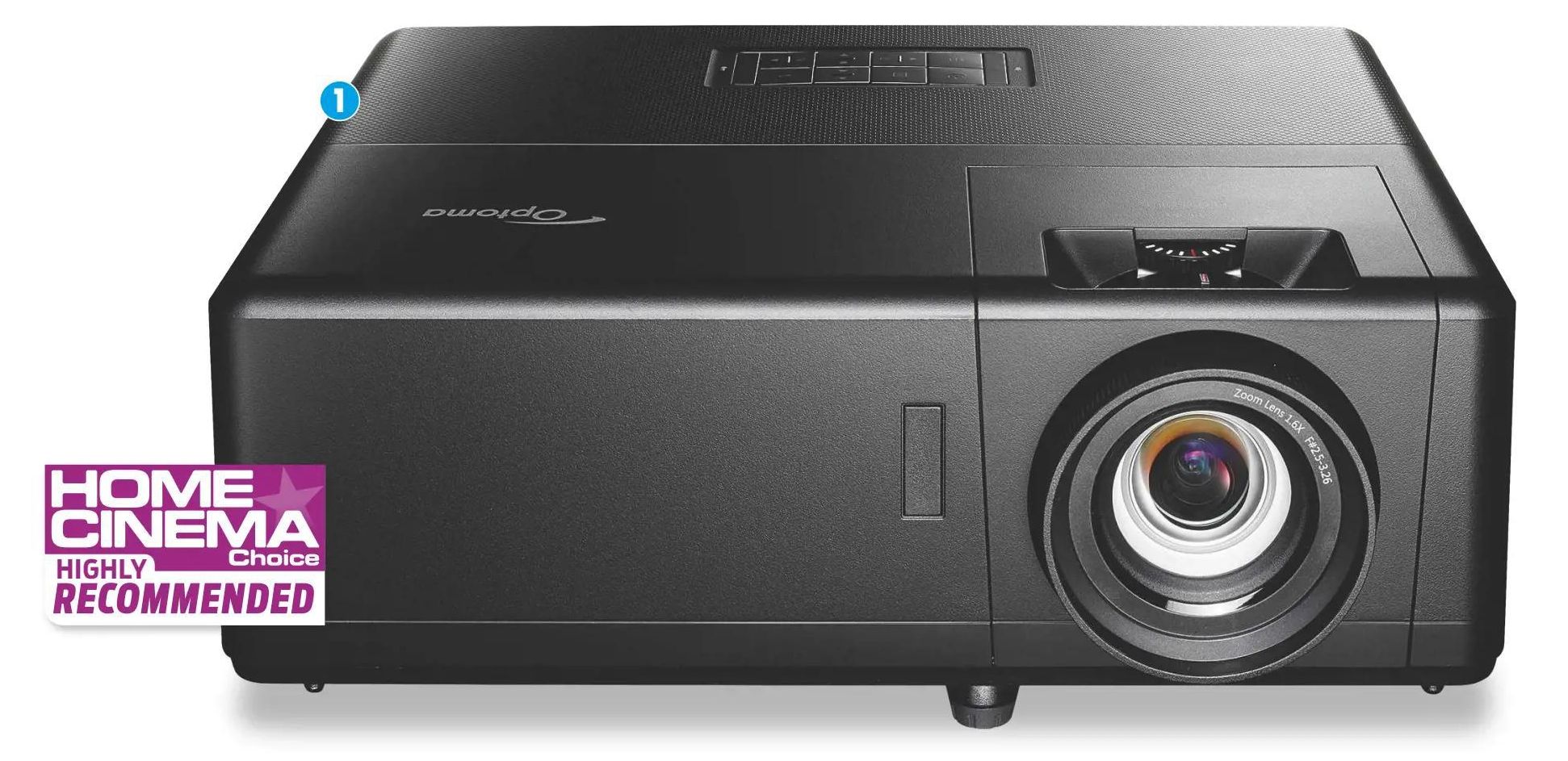
Let it shine
Darkroom or bright, Optoma’s new 4K laser projector is a star in both [that’s enough puns now – Ed]. A minor update of 2022’s UHZ50 model, it again uses the brand’s ‘DuraCore’ laser light source, here rated at 3,000 Lumens and claiming a 2,500,000:1 dynamic contrast ratio. In use, it makes some rivals look a little dull. Even gamers could be persuaded to get on board, thanks to input lag as low as 17ms (1080/60), plus an HFR mode of 240Hz (1080p) for PC gamers.
The UHZ55’s build quality is fine, even if the model slavishly follows the rather functional design of its predecessor, with an offset lens and compact black cabinet. This projector shouldn’t attract too much attention if ceiling mounted and is light enough (4.8kg) to be pulled from storage and set up on a coffee table if you’d rather take a more casual approach.
Connectivity is impressive, with Optoma now including three HDMI inputs (one that supports eARC), alongside three USB-A ports (one to provide power to a streaming stick), an analog stereo 3.5mm minijack output, a digital audio output, Ethernet, and 3D emitter port. The UHZ55 can be an optional extra with DLP’s 3D Sync system.
Wi-Fi comes via a supplied dongle, but this aspect of the UHZ55 is not really for home users. In conjunction with Optoma’s Creative Control app, it allows the PJ to be shared with workers in a boardroom environment by generating a WPS pin that stays on the screen. This only disappears when you disable Wi-Fi.
This professional AV proclivity extends to the projector’s Home screen, including date and time, icons for Optoma Connect, Creative Cast, and a File Manager, and input selection and settings. It’s a very serious front end that might have you cocking a wistful glance at challenger models with Android-based Uls.
VOD apps available to download from Optoma’s ‘Marketplace,’ including Prime Video, Netflix, Crunchyroll, and Spotify, but using them just feels clunky.
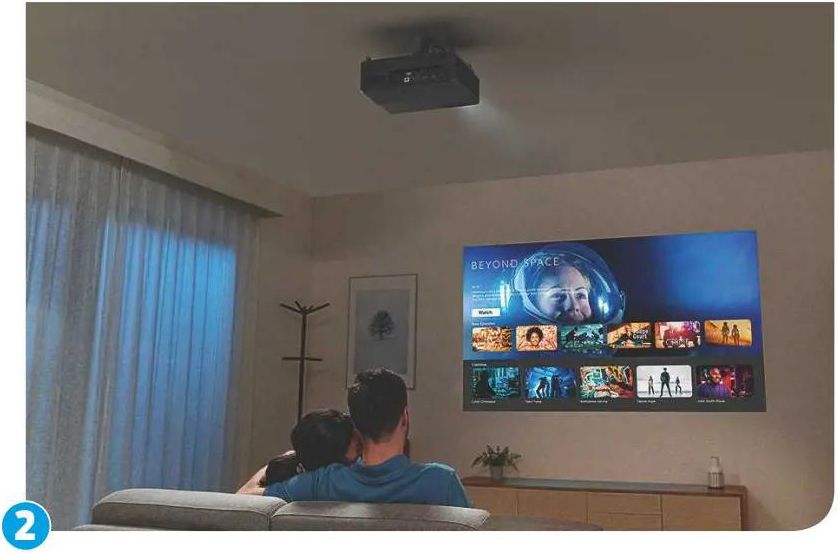
Better to plug in an exterior source, like a Amazon Fire TV or Roku stick.
More impressive are the UHZ55’s installation options, which include vertical lens shifting, horizontal/vertical/ auto keystone, and geometric correction. Focus (from 1.2m) and zoom (1.3x) are manually adjusted, and the throw ratio is 1.21-1.59:1. If you intend to project onto a wall rather than a screen, Optoma has a variable Wall Colour balance setting, with filters for light yellow, light green, light blue, pink, grey, and ‘blackboard’.
Clinical clarity
The UHZ55 supports HDR10 and HLG, but neither Dolby Vision nor HDR10+. Brightness modes include Eco to lower power consumption, but you’ll get a better sense of punch if you leave the projector on its Dynamic Black setting.
With HDR content, Optoma’s unit does a fair job of lifting light levels without sacrificing shadow detail. Unfortunately, HDR also causes the projector’s fan to go into hyper drive, hitting a noisy 29dB.
Extraction 2, playing in 4K HDR via Netflix, looks gorgeous, with superb fine detail and steely hues’ mirror-flipping to achieve its 3,840 x 2,160 pixel image. It’s easy to forget that this isn’t a native 4K projector.
Picture quality is outstanding, though. As I’ve come to expect from single-chip DLP projectors, fine detail and texture have clinical clarity. This never fails to amaze me given that Texas Instruments’ technology is using crafty Picture presets cater to various tastes (there’s an HDR Sim mode for standard dynamic range sources), and the UHZ55’s image calibration options (gamma, colour management, etc) will appeal to tweakers. For SDR movie content, Optoma’s Cinema present gives the best overall balance between contrast and colour vibrancy, while inputting an HDR source sees a standard HDR preset take charge, albeit with a further choice of picture modes.
The explosive action flick Extraction 2, playing in 4K HDR via Netflix, looks gorgeous, with superb fine detail and steely hues. The image looks extremely filmic too, with decent motion handling even if you don’t instigate the manufacturer’s PureMotion MEMC processing (which is only an option through the HDMI 3 input).
The UHZ55 also looks particularly fine with SDR material. Wonder Woman (Blu-ray) demonstrates just how good the projector is with scenes of high brightness, particularly the early sequences on the island of Themyscira. Black level performance is rather good, too, with movie bars rendered a satisfying dark grey.
The familiar DLP trait of rainbow flashing in areas of high contrast was occasionally visible, but I can’t say it pulled me out of the viewing experience. I tended to notice the artefact most often on subtitles, where white sits in stark contrast to the background. Some viewers may not see it at all.
Unsurprisingly, the UHZ55’s built-in sound system is somewhat rudimentary. At 10W, it serves when the unit has been pulled out for casual entertainment, but if you intend to get theatrical, it should be partnered with an exterior sound system. WiSA HT certification means you could partner it with WiSA-enabled wireless speakers, although these aren’t particularly common.
Pop star
The UHZ55 treads a line between home entertainment and business-minded projector regards its smart skills, but doesn’t drop the ball when it comes to image quality. The laser light engine is bright and punchy, picture sharpness is excellent, and there’s a pleasing feeling of authority to the way it approaches HDR, SDR and a wide variety of content genres. If you’re auditioning new PJs, it should rank high on your charts.
OPTOMA UHZ55 TECH SPECS
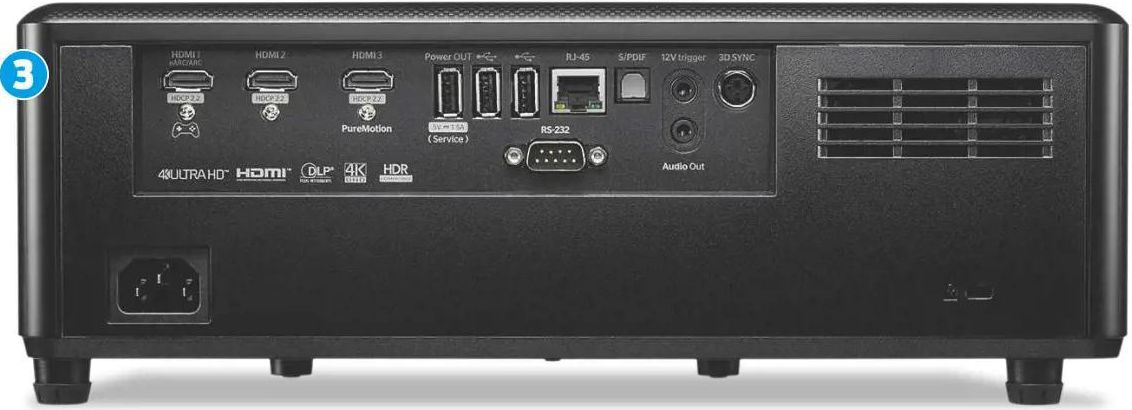
| Product | 4K HDR DLP laser projector |
| Position | Near the top of Optoma’s huge range of 4K projectors |
| Peers | BenQ W5700; Epson EH-LS650W |
| Website | optoma.co.uk |
| 3D | Yes. Active shutter |
| 4K | Yes. 3,840 x 2,160 via DLP mirror-flashing tech |
| HDR | Yes. HDR10; HLG |
| Connections | 3 x HDMI inputs (1 x eARC); digital optical audio output; 3.5mm analogue audio output; 3 x USB (1 x powered); Ethernet; RS-232; 12V trigger; 3D Sync emitter port |
| Brightness (claimed) | 3,000 Lumens |
| Contrast (claimed) | 2,500,000:1 (dynamic) |
| Zoom | 1.3x |
| Dimensions (WxHxD) | 337 x 119 x 265 mm |
| Weight | 4.8 kg |
| Features | DLP single-chip laser projector, 10W built-in audio, laser life rated at 30,000 hours, 29dB max rated fan noise, ISF, Cinema, HDR, HDR Sim, Game, Reference and Bright picture presets, throw ratio 1.21-1.59:1, PureMotion, 240Hz 1080p gaming mode, WiSA HT certified, Wi-Fi dongle, Optoma Marketplace |
TESTED WITH

TAYLOR SWIFT: THE ERAS TOUR: Not so much a concert movie as a pop culture phenomenon, this billion-dollar-grossing stage show, directed by Sam Wrench, streams in an extended cut on Disney+ and is a peerless AV experience with spectacular cinematography running the gamut of color and contrast.
Verdict
When you purchase through links on our site, I may earn an affiliate commission. Here’s how it works.






